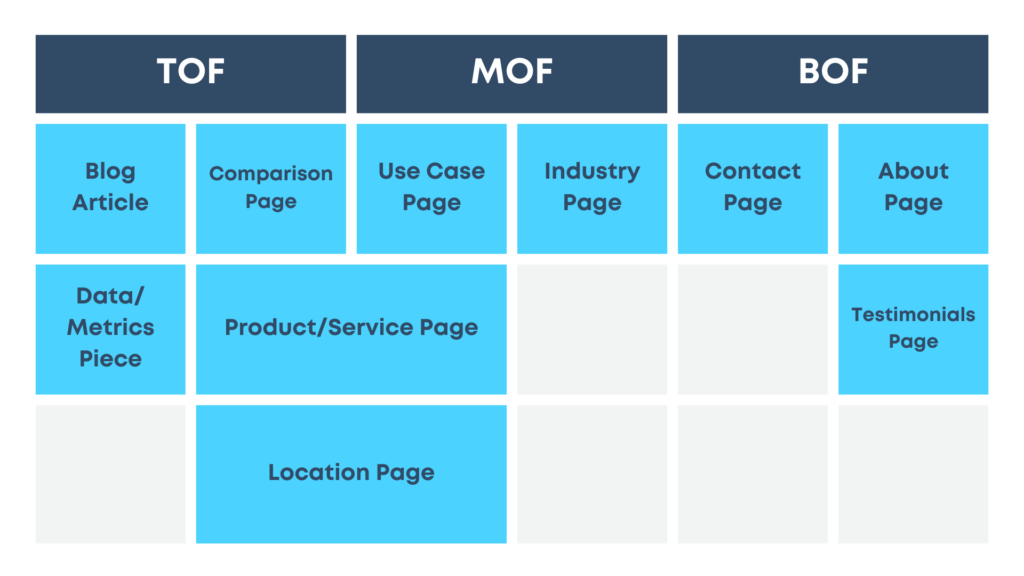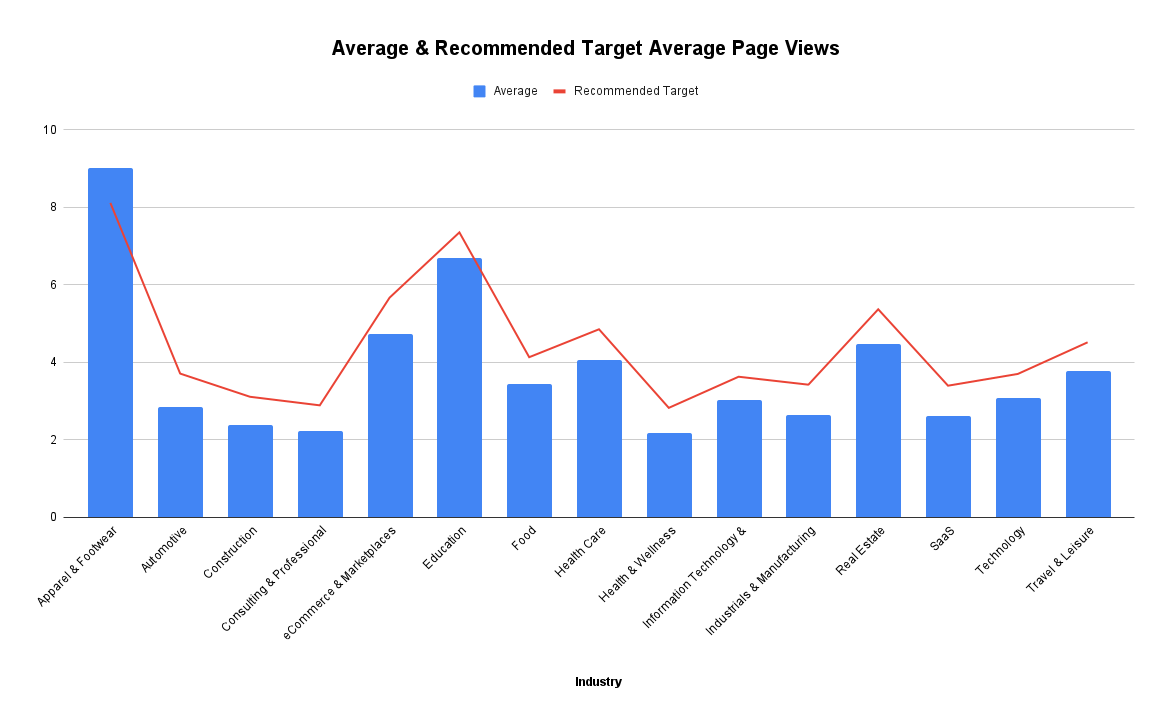Average pages per session is a metric with arguably the closest correlation with user satisfaction from the content curated on a website page. While average session duration is important, the metric does not sufficiently account for the true purpose of top-of-funnel content: moving visitors through the funnel, towards more conversion-oriented content.
The following graphic shows our general breakdown of the top-of-funnel, middle-of-funnel, and bottom-of-funnel content. This graphic references our 11 strategic page types, each strategically designed for conversion in a specialized sequential order beginning with pages designed to generate traffic, to pages with mixed-use between traffic generation and conversions, to pages meant solely to convert traffic once it landed on the site.
Content Structure: Traffic Should Naturally Flow from Left to Right
When pages per session are tracked properly, we are looking to see traffic generated in the top-of-funnel segment of the content structure, with the middle of the funnel serving as a transitionary stage between traffic generation and traffic conversion.

In the remainder of this report, we will outline industry benchmarks for average pages per session and the benchmark KPIs for the maximum chance of conversion to a qualified lead.
Average Pages per Session: Industry Benchmarks
The following table outlines the industry benchmarks for average pages per session. We also included a recommended target page views per session by industry for optimal conversions.
| Industry | Average | Recommended Target |
|---|---|---|
| Apparel & Footwear | 9.01 | 8.11 |
| Automotive | 2.85 | 3.71 |
| Construction | 2.39 | 3.11 |
| Consulting & Professional Services | 2.22 | 2.89 |
| eCommerce & Marketplaces | 4.72 | 5.66 |
| Education | 6.68 | 7.35 |
| Food | 3.44 | 4.13 |
| Health Care | 4.04 | 4.85 |
| Health & Wellness | 2.17 | 2.82 |
| Information Technology & Services | 3.02 | 3.62 |
| Industrials & Manufacturing | 2.63 | 3.42 |
| Real Estate | 4.47 | 5.36 |
| SaaS | 2.61 | 3.39 |
| Technology | 3.08 | 3.70 |
| Travel & Leisure | 3.76 | 4.51 |
As you can observe, industries with a higher number of selections generally have higher average page views per session, as the prospect will be much more keen on understanding the different product lines before purchasing or becoming a lead. This may be surprising to some who expect the price of the product to determine the page views, but this does not seem to be accurate. One possible explanation of this is the fact that with higher priced products, prospects may be apt to view only pages specific to them such as use case or industry pages, versus browsing many different pages.
You’ll notice that in some industries, we actually recommend fewer page views than the average is, as too many page views indicate a lack of ability to find the information one is looking for or difficulty in making a decision. This also negatively impacts conversions.
Average Page Views per Session by Price Point of Product
In this analysis, we segmented our sample into specific price points instead of industries to draw out our analysis for those who may not see their industry above. The same as before, we also included our recommended target for page views per session to give the maximum chance of conversion.
| Price Point Range | Average | Recommended Target |
|---|---|---|
| $5 – $30 | 7.5 | 8 |
| $20 – $150 | 6.8 | 7.5 |
| $50 – $300 | 5.6 | 6 |
| $100 – $1,000 | 4.8 | 5.3 |
| $1,000 – $10,000 | 3.5 | 4 |
| $5,000 – $50,000 | 3 | 3.5 |
| $10,000 – $50,000 | 2.8 | 3.3 |
| $15,000 – $40,000 | 2.7 | 3 |
| $40,000 – $100,000 | 2.5 | 2.8 |
| $50,000 – $500,000 | 2.4 | 2.7 |
| $100,000 – $1M+ | 2.3 | 2.5 |
| $500,000 – $5M+ | 2.2 | 2.4 |
Average Pages per Session: Benchmarks by Traffic Channel
In this table, we’ve outlined pages per session benchmarks by traffic channel. In general, organic channels still result in a higher pages per session benchmark as the traffic sought out the company and is visiting from a deeper level of interest (in general) than a paid prospect.
| Traffic Source | Average Pages per Session |
|---|---|
| SEO (Organic Search) | 5.8 |
| Direct Traffic | 4.3 |
| Referral | 4 |
| Email Marketing | 3.6 |
| Social Media | 3.2 |
| Paid Search | 2.9 |
Improving Your Average Pages per Session
The best way to improve your average pages per session is to write content that is more satisfying to the visitor by taking the time to understand the strategic purpose of each page. Pages such as blogs are meant to present visitors with content positioning your brand as a thought leader, not to sell the product. Product or service pages are meant to display benefits and sell your product as an option, not convey the story of your brand. The about page should connect visitors with the personal side of your business, not advertise the products.
By understanding the purpose of each page, we can improve the average pages per session, as the visitor will naturally progress from the top of the funnel to the middle of the funnel to the bottom of the funnel as they are sold on your thought leadership, your products, and finally, your company. These must be taken in this order, as it is a mirror of human psychology.
Next Steps & Further Reading
If you are interested in reading further on this topic, we recommend the following articles:
- Customer Acquisition Cost Benchmarks by Industry
- Customer Acquisition Cost Trends
- Full Video SEO Training
If you are interested in learning more about implementing a content strategy that satisfies user intent and moves them further down the funnel toward becoming a lead, we are happy to consult. Feel free to contact us here.
Sources:
